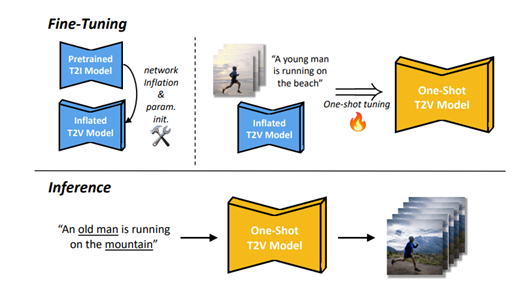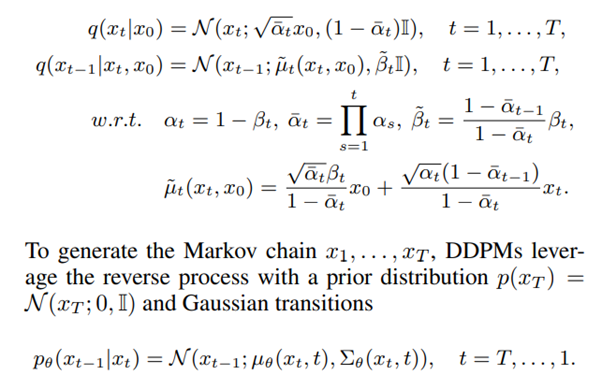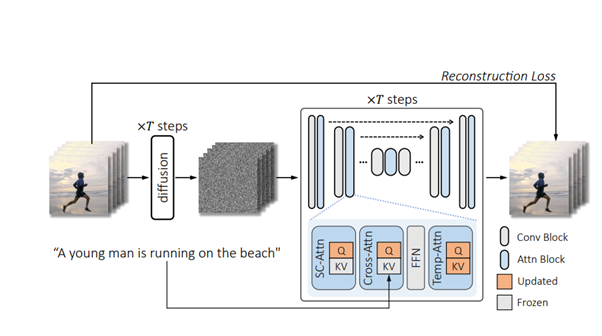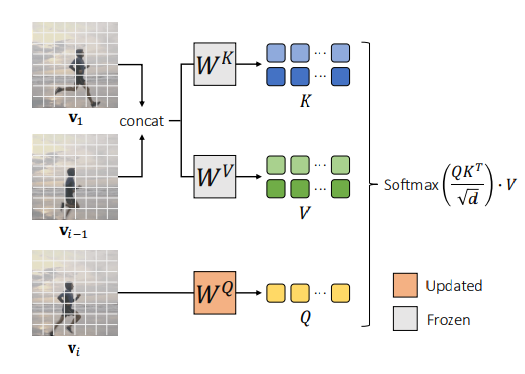papers_we_read
Tune-A-Video: One-Shot Tuning of Image Diffusion Models for Text-to-Video Generation
Jay Zhangjie Wu, Yixiao Ge, Xintao Wang, Stan Weixian Lei, Yuchao Gu, Wynne Hsu, Ying Shan, Xiaohu Qie, Mike Zheng Shou ICCV 2023
SUMMARY
-
Introduces a novel problem of One-Shot Video Generation, which eliminates the burden of training with largescale text-video datasets for T2V generation.
-
Provides intriguing properties of pre-trained T2I models on T2V generation, and for the first time generate videos from text prompts via an efficient one-shot tuning of pre-trained T2I diffusion models.
-
Tune-A-Video, is capable of generating temporally-coherent videos with customized attributes, subjects, places, etc.
METHOD
The method is based on Denoising Diffusion Probabilistic Models (DDPMs) and Latent Diffusion Models (LDMs). Then the problem setting is formulated presenting the approach Tune-A-Video that adapts pre-trained T2I models to one-shot video generation.
Given shows an overview of the method.

Denoising Diffusion Probabilistic Models (DDPMs)
- DDPMs recreate a forward Markov chain using Gaussian transitions and variational inference.

Latent Diffusion Models (LDMs)
LDMs consist of two key components.
-
First, an autoencoder which is trained with patch-wise losses on a large collection of images, where an encoder E learns to compress images x into latent representations z = E(x), and a decoder D learns to reconstruct the latent back to pixel space, such that D(E(x)) ≈ x.
-
The second component is a DDPM, which is trained to remove the noise added to a latent representation of an image. This diffusion model can be conditioned on encoded embeddings of class labels, texts, or segmentation masks.
One-Shot Video Generation
Given a video $V = {v_i | i \in [1, m]}$ with $m$ frames, accompanied with a corresponding textual description $T$, the objective of one-shot video generation is to generate novel videos $\hat{V}$ driven by text prompts $\hat{T}$ using a pre-trained T2I model $M$, i.e., $M(V | \hat{V}, T, \hat{T})$, where $T$ and $\hat{T}$ share the same verbs.
Our Tune-A-Video
In Tune-A-Video, the T2I diffusion model is inflated using a U-Net architecture with 2D convolutional residual blocks and attention blocks. The attention blocks include spatial self-attention and cross-attention, considering pixel correlations and conditional inputs (e.g., text). Initially, 1 × 3 × 3 convolution kernels and temporal self-attention with a causal mask are used. However, it is observed that this is insufficient for consistent content generation in One-Shot Video Generation. As a result, spatial self-attention is further inflated to cross-frame attention.

Training pipeline of Tune-A-Video. This method takes as input a videotext pair and only updates the projection matrices (orange) in attention blocks.

Sparse-Causal Attention (SC-Attn)
One-Shot Tuning
In one-shot tuning for One-Shot Video Generation, we fine-tune the inflated T2V models using Sparse-Causal Attention (SC-Attn) and temporal self-attention (Temp-Attn). SC-Attn models the one-way mapping from the current frame to its previous frames, allowing independent updates of key and value features. We update the query projection in cross-attention (Cross-Attn) and fine-tune the entire Temp-Attn layers. This fine-tuning process is computationally efficient and maintains the properties of diffusion-based T2I models
Results
Quantitative results

Qualitative results
The model integrates the motion guidance from the training video with the rich semantics of pre-trained T2I models for high temporal consistency and deep language understanding.
Conclusion
Tune-A-Video, a simple yet effective solution based on pre-trained T2I diffusion models. Our method exploits the properties of pre-trained T2I models by extending spatial self-attention to the spatiotemporal domain with tailored Sparse-Causal Attention. To capture necessary motion knowledge, we update the projection matrices in the attention block on one training sample. Given this, our Tune-A-Video supports several T2V applications, including subject replacement, background change, attribute modification, style transfer, etc.
Resources
Paper: https://arxiv.org/pdf/2212.11565v1.pdf